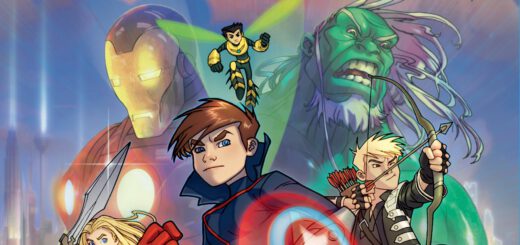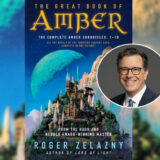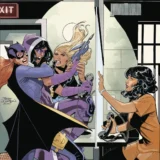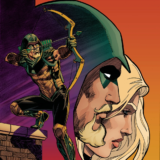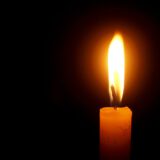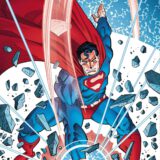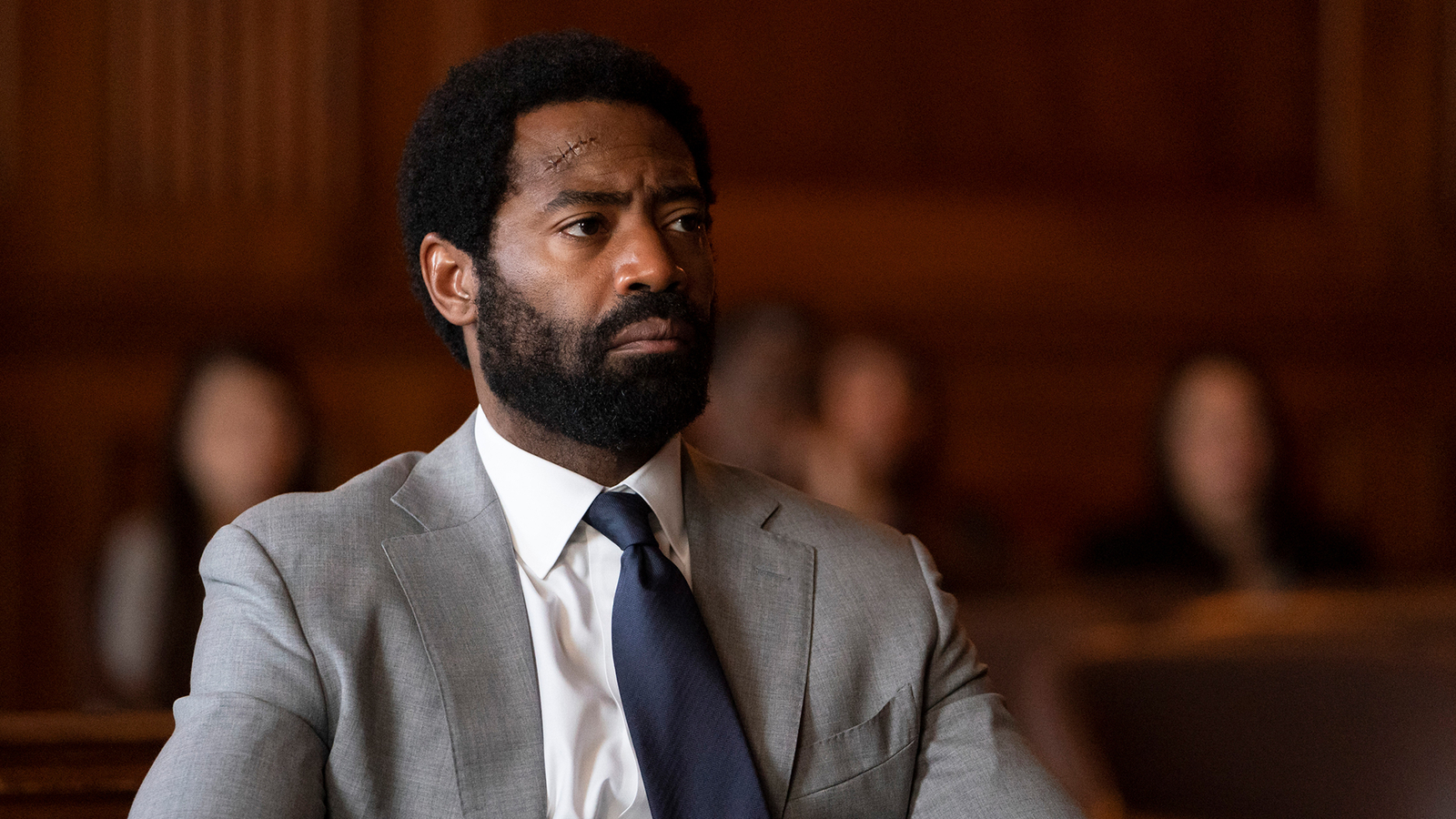Graphic Novel Review: The Best American Comics 2007
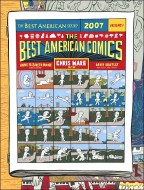 With two years of The Best American Comics
With two years of The Best American Comics down now, it’s clear just how much the individual editor can influence the choice of comics. Last year, Harvey Pekar leaned towards autobiographical comics and towards long, complete works. For this second year, Chris Ware similarly goes where we’d expect him to go and picks a lot of formalist stories — but also a lot of autobiography, particularly the overly-serious type. It’s dangerous to compare annuals in any case, especially when they change editors, but I have to admit that I thought 2006 was a stronger book than 2007; this year’s edition contains a batch of “experimental” comics that I found pointless and a pure waste of space.
And there’s also the meta-question of what are the “best comics,” since even the “100 Distinguished Comics” list in the back matter — from series editor Anne Elizabeth Moore, and which also apparently served as the first cut of stories from which Ware built this anthology — lists only a tiny handful of stories from the major comics publishers. So this series is essentially for the best American independent comics — not superheroes, or adventure stories of any type from the big companies. Perhaps future volumes will challenge that idea, but, for now, there’s no sign that Best American is open to anything more fantastic or adventurous than Charles Burns’s great horror comic Black Hole.
Before I start talking about what’s in this anthology, let me explain some of the deep, dark secrets of anthology-making. Once the editor has a rough list of the stories to be included (subject to rights problems, space constraints, and all the other insults flesh is heir to), he generally ranks them, roughly, from best to worst. The top two stories go at the beginning and the end, one way or the other. The next-strongest story, or a high-ranked very long story, goes right in the middle. The rest is then assembled around those milestones, depending on tone, mood, and other balancing factors. (Ware’s introduction mentions that, in a comics anthology, the editor also has to worry about page spreads, and left- and right-hand orientation.)
In the end, one has to place the stories at the bottom of the list — the worst stories in the anthology. There are two schools of thought as to where to put them. Some people think the worst stories should go right after the first story, so that initial momentum gets the reader past them and that they’ll be mostly forgotten by the end. The other theory is that you should bury those stories right before the end, since readers will be reading quickly by that point, and fully involved with the anthology. It’s possible that Ware has very different tastes than I do, but I think he belongs to the second school.
BAC07 has two strips — a single pager by Ivan Brunetti (yet another poor-me vignette; I don’t think I’ve ever seen anything else from Brunetti) and four pages of short stories from an ongoing project by Art Spiegelman — before the table of contents, which worried me. (Brunetti’s An Anthology of Graphic Fiction, Cartoons, & True Stories last year started off the same way, and had a useless, cartoon-style ToC.) But the ToC then showed up in BAC07, and was just as useful and informative as last year’s.
After a long preface by Moore and a longer introduction by Ware, the comics start up in earnest. We get a heavy dose of autobiography to begin with:
- R. and Aline Crumb visit their daughter, Sophie, in New York
- Sophie Crumb has a single-pager about how other comics are lame
- There’s a long, excellent excerpt from Alison Bechdel’s Fun Home
- And two very colorful but facile strips from C. Tyler (didn’t she used to have a real first name?)
Four pages of Lynda Barry’s “Marlys” strips break up the relentless flow of autobio, but then we dive right back in:
- Five scratchy, flatly-colored pages of bland teenage angst from Lauren Weinstein
- Four pages of pleasant vignettes by Vanessa Davis – very appealing, but they don’t add up to anything
- A longer section of comics diary from Gabrielle Bell, covering a trip to California; this one almost has the shape of a story, and is the most successful of this stretch
- Another page of woe from Brunetti
- A long stretch of four minicomics pages to a page from Jeffrey Brown
- And a long, mostly autobiographical story in an unattractive style and laid out in a confusing way by Ron Rege, Jr.
After yet more autobiography — a pleasant but slight mood piece by John Porcellino, and a nice meditation on pigeons and nails by Jonathan Bennett — we finally get into fiction. Well, sort of: it’s “Glen in Bed” by Kevin Huizenga — one of the best pieces in the book, incidentally — and I do suspect that Huizenga’s “Glen Ganges” character is at least partially based on himself. Then come some dream comics by David Heatley, whose ‘70s-primitivist style I’m afraid I’ve never warmed up to. And dream comics are ridiculously self-indulgent to begin with; I suspect they’re of the most interest to people who already know the cartoonist.
Finally, a third of the way into the book, we get strip that are clearly not the story of an “independent” cartoonist in the early 21st century: Sammy Harkshaw’s “Lubavich, Ukraine, 1876,” and Miriam Katin’s “Untitled (The List).” Both are stories of Jews in difficult times and places, and both are real stories about real characters, not just ramblings about one’s own obsessions and life. (It’s no accident that they’re some of the best work in the book.) Continuing the Jewish subsection is another one of Ben Kachor’s incomprehensible strips about unlikely commercial enterprises in unnamed cities; I’ve never had a clue what Kachor was trying to do, so I won’t try to explain any further.
We’re now hitting the mid-point of the book — where some of the best stories should be placed, if you remember my paradigm above — and so we get a long excerpt from Adian Tomine’s Shortcomings and a similarly long Gilbert Hernandez story, “[[[Fritz After Dark]]].” (Separated by two single-page Heatley dream strips; I think just as a color and tone break between two long, serious, black and white stories.) These are big, serious, fictional strips — though I’m not convinced that Ware excerpted the most appropriate part of [[[Shortcomings]]] — and anchor the middle of the book well. Immediately following the Hernandez strip is another heavyweight, Kim Deitch’s “[[[No Midgets in Midgetville]]],” which pretends to be autobiographical even though it’s complete fiction (at least, I hope it is).
A surreal strip with talking birds and a bark-eating man by Anders Nilsen follows, and then an excerpt from Charles Burns’s Black Hole. (It’s a very quiet, contemplative part of Black Hole, which is not entirely representative of the book as a whole – I wonder if Ware deliberately chose this excerpt because it didn’t have any hint of the horror aspect of Black Hole, and was thus more “serious.”)
Another cartoonist I’ve never really understood, Gary Panter, follows, with a confusing, hard-to-follow excerpt from Jimbo’s Inferno. (It’s also one of many strips in the book with copyright dates up to a decade in the past written into the artwork – in this case 1996. I thought this book was supposed to be the best of the current year?) After that is a similarly surreal strip by someone billed as C.F. I hate to say so, but I hated this from beginning to end. Then another Bunetti page of woe, a two-page ‘60s music pastiche by Tim Hensley, and another long, visually obnoxious, confusingly unpleasant strip – this time “Kramer’s Ergot” by the “art collective” Paper Rad. Yet more strips of David Heatley’s dreams follows, adding up to nearly fifty pages of stuff I can’t stand.
What seems to be the last entry in the book is family autobiography, as Dan Zettwoch retells the story of his grandfather and the 1937 Louisville flood in “[[[Won’t Be Licked]]].” It’s drawn with style and energy, and shows a good eye for details of the time. But it’s yet another very introspective strip, which causes it to lose some of its power after so much navel-gazing over the past three hundred pages.
Contributors’ Notes and the official “100 Distinguished Comics” list follows, which seems to finish up the book…but wait! Seth’s “Wimbledon Green” follows, as if an afterthought. It’s light-hearted and pleasant, and Green’s collector’s mania is the only reference to the world of mainstream pamphlet comics in the entire book. Is Seth’s story’s placement deliberate? Does it mean anything? I don’t really know, but it’s certainly suggestive.
Every reader’s reaction will be different, but, for this reader, [[[The Best American Comics 2007]]] was clearly inferior to last year’s edition, and even less representative of the breadth of the field. It does have a number of excellent stories, but it also has some stories that are less than excellent, and a few that I’m sorry I even looked at. The book is only $22, which is quite reasonable for a hardcover book this size full of color comics, but each reader will have to look at the line-up and decide if it’s worth the price.
(Obligatory linkity links: last year, I reviewed Best American Comics 2006 on my personal blog, and more recently compared it to the Ivan Brunetti-edited An Anthology of Graphic Fiction, Cartoons, & True Stories. Oh, and The Beat’s Heidi Thompson had a similar reaction to mine a few days ago.)
The Best American Comics 2007
edited by Chris Ware; series editor Anne Elizabeth Moore
Houghton Mifflin, 2007, $22.00


